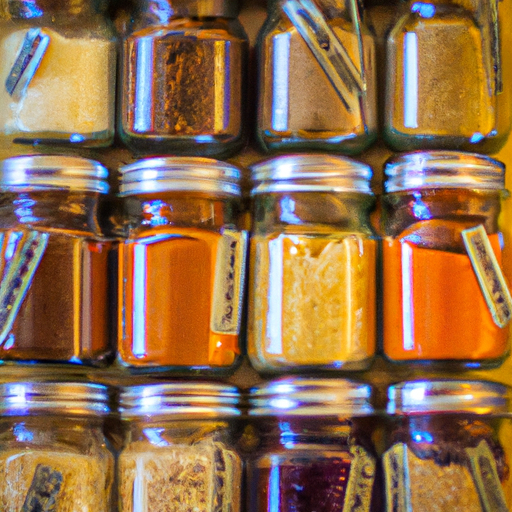Spice up your cooking game with DIY spice blends! Elevate your culinary creations to new heights with the perfect mix of flavors and aromas. At Tastepan.com, we understand the importance of crafting delectable dishes that tantalize your taste buds. From warm and comforting spices for hearty stews to exotic blends that transport you to far-off lands, our step-by-step instructions and expert tips will guide you in creating mouthwatering meals that will impress even the most discerning palates. Get ready to embark on a flavorful journey and discover the magic of homemade spice blends.

Benefits of Making Your Own Spice Blends
Making your own spice blends can be a game-changer in the kitchen. Not only does it give you the freedom to control the quality and freshness of the ingredients, but it also allows for customization and personalization tailored to your taste preferences. Moreover, making your own spice blends can be cost-effective in the long run. Let’s explore these benefits and discover why creating your own spice blends can elevate your culinary creations.
Control over Ingredients
One of the major advantages of making your own spice blends is having complete control over the ingredients you use. When you buy pre-packaged spice blends from the store, you often have no idea what goes into them. By making your own blends, you can ensure that you are using high-quality spices and avoid any additives or preservatives that may be present in store-bought blends. This allows you to create healthier and more flavor-packed dishes without compromising on taste or quality.
Customization and Personalization
Another great benefit of making your own spice blends is the ability to customize and personalize them according to your own tastes and preferences. By experimenting with different combinations and ratios of spices, you can create blends that perfectly suit your palate. Whether you like your dishes spicier, milder, or with a specific flavor profile, making your own blends empowers you to tailor them to your liking. This level of customization can bring your dishes to a whole new level and truly make them your own.
Cost-Effective
While the upfront cost of buying individual spices may seem higher than purchasing pre-made blends, making your own spice blends can actually be more cost-effective in the long run. When you buy pre-packaged blends, you are paying for the convenience and marketing associated with the product. By purchasing individual spices in larger quantities and blending them yourself, you can save money and get more bang for your buck. Plus, since you have control over the proportions, you can adjust the recipe to fit your budget without compromising on flavor.
Freshness and Quality
Nothing compares to the aroma and flavor of freshly ground spices. When you make your own spice blends, you have the advantage of using freshly ground spices, which can greatly enhance the overall taste of your dishes. Pre-packaged blends often lose their freshness and potency over time, leading to lackluster flavors. By grinding your own spices and blending them as needed, you ensure that each dish is infused with the highest quality and freshest flavors. This can truly elevate your culinary creations and make them stand out.
Essential Spices for Making Spice Blends
Before diving into the world of spice blends, it’s important to familiarize yourself with some essential spices that form the foundation of many blends. These spices add depth, aroma, and flavor to a wide range of dishes. Here are ten essential spices you should have in your pantry when embarking on your spice blend journey:
Cumin
Cumin seeds have a warm and earthy flavor with a slightly nutty undertone. They are commonly used in Indian, Mexican, Middle Eastern, and North African cuisines. Cumin adds a distinct smokiness and depth to spice blends and pairs well with other spices like coriander and turmeric.
Cinnamon
Cinnamon is a versatile spice with a warm and sweet flavor. It is commonly used in both sweet and savory dishes, adding a touch of warmth and complexity. Along with its culinary uses, cinnamon is also known for its health benefits, such as its anti-inflammatory properties and ability to regulate blood sugar levels.
Paprika
Paprika comes in various forms, ranging from sweet to hot and smoky. It adds vibrant color and a slightly sweet, earthy flavor to dishes. Paprika is often used in spice blends, rubs, marinades, and stews, and is a staple in Hungarian and Spanish cuisines.
Turmeric
Turmeric has a bright yellow color and a mildly bitter, earthy flavor. Not only does it add a vibrant hue to dishes, but it also boasts numerous health benefits, thanks to its active compound, curcumin. Turmeric pairs well with other warm spices and is commonly used in curries, rice dishes, and golden milk.
Coriander
Coriander seeds have a subtly sweet and citrusy flavor with a warm undertone. Ground coriander is a versatile spice that can be found in spice blends from various cuisines, such as Indian, Mexican, Middle Eastern, and Mediterranean. It complements other spices well and adds a refreshing touch to dishes.
Ginger
Ginger has a zesty and slightly peppery flavor with a hint of sweetness. It can be used fresh, dried, or ground, and brings warmth and depth to spice blends. Ginger is a common ingredient in Asian cuisines and pairs well with other warm spices like cinnamon, cloves, and nutmeg.
Cloves
Cloves have a strong, pungent, and sweet flavor with a hint of bitterness. They are often used whole or ground in spice blends, marinades, and desserts. Cloves add warmth and depth to dishes, and their aroma is especially prominent during the holiday season.
Cardamom
Cardamom has a unique and aromatic flavor with hints of citrus and floral notes. It is commonly used in both sweet and savory dishes and is a key ingredient in Indian chai tea. Cardamom pods contain small seeds that are ground and used in spice blends to add a complex and exotic flavor.
Nutmeg
Nutmeg has a warm and slightly sweet flavor with hints of clove and cinnamon. It is often used in both sweet and savory dishes, adding depth and warmth. Nutmeg pairs well with other spices like cinnamon and cloves, and is commonly found in spice blends, baked goods, and sauces.
Black Pepper
Black pepper is a ubiquitous spice known for its sharp and spicy flavor. It adds a kick to dishes and enhances the taste of other spices. Black pepper is a versatile spice that can be used in various spice blends and is widely used in cuisines around the world.

Common Spice Blends and Their Uses
Now that we have explored the essential spices, let’s dive into some common spice blends and their culinary uses. These blends represent different cuisines and can be used to enhance the flavor profiles of various dishes. Each blend has its unique combination of spices that work together harmoniously to create a distinct and balanced taste. Here are ten common spice blends and their uses:
Curry Powder
Curry powder is a staple in Indian cuisine and adds a vibrant flavor to curries, rice dishes, and marinades. It typically consists of a blend of spices like coriander, cumin, turmeric, fenugreek, and cardamom. The exact composition of curry powder can vary depending on the region or personal preference, but it generally lends a warm, earthy, and slightly spicy flavor to dishes.
Italian Seasoning
Italian seasoning is a classic blend that is commonly used in Italian-American dishes. It typically includes a combination of herbs like basil, oregano, thyme, rosemary, and marjoram. Italian seasoning brings a Mediterranean flair to dishes and is perfect for pasta sauces, roasted vegetables, meatballs, and pizza.
Taco Seasoning
Taco seasoning is a must-have for Tex-Mex and Mexican-inspired dishes. It usually comprises a mix of spices like chili powder, cumin, paprika, garlic powder, onion powder, oregano, and red pepper flakes. Taco seasoning adds a savory and slightly spicy kick to ground meat for tacos, fajitas, burritos, and enchiladas.
Herbes de Provence
Herbes de Provence is a traditional French blend that brings the flavors of the Provence region to dishes. It typically includes a combination of dried herbs like thyme, rosemary, marjoram, savory, and oregano. Herbes de Provence adds a fragrant and subtly herbal taste to roast chicken, grilled vegetables, and stews.
Chinese Five Spice
Chinese Five Spice is a popular blend in Chinese cuisine and creates a harmonious balance of flavors. It usually consists of star anise, cloves, Chinese cinnamon, Szechuan peppercorns, and fennel seeds. Chinese Five Spice brings a sweet and aromatic taste to stir-fries, roasted meats, and braised dishes.
Garam Masala
Garam masala is a key spice blend used in Indian cooking and adds warmth and complexity to dishes. It typically combines spices like coriander, cumin, cardamom, cinnamon, cloves, and black pepper. Garam masala is often added towards the end of cooking to enhance the flavors of curries, rice dishes, lentils, and meat gravies.
Cajun Seasoning
Cajun seasoning is a vibrant blend hailing from the Louisiana region in the United States. It usually includes spices like paprika, cayenne pepper, garlic powder, onion powder, and dried herbs like thyme and oregano. Cajun seasoning brings a spicy, smoky, and slightly herbaceous flavor to dishes like gumbo, jambalaya, seafood boils, and blackened meats.
Ras el Hanout
Ras el Hanout is a complex and aromatic spice blend commonly used in North African and Moroccan cuisines. It translates to “top of the shop,” indicating the best spices a merchant has to offer. Ras el Hanout typically includes a blend of spices like cumin, coriander, cinnamon, ginger, turmeric, cloves, cardamom, and chili peppers. It adds a rich, warm, and slightly sweet taste to tagines, couscous, grilled meats, and roasted vegetables.
Pumpkin Spice
Pumpkin spice is a beloved seasonal blend associated with the flavors of autumn. It typically includes spices like cinnamon, ginger, nutmeg, allspice, and cloves. Pumpkin spice adds a warm and aromatic taste to pumpkin pie, lattes, quick breads, and other fall-inspired treats.
Chili Powder
Chili powder is a versatile blend consisting of ground chilies mixed with other spices. The exact composition can vary depending on regional preferences, but it often includes spices like cumin, paprika, garlic powder, onion powder, and oregano. Chili powder adds a smoky, spicy, and robust flavor to chili con carne, stews, marinades, and grilled meats.
Tips and Techniques for Making Spice Blends
Now that you have a good understanding of the benefits of making your own spice blends and have been introduced to some essential spices and common blends, let’s explore some tips and techniques to ensure successful spice blending. These tips will help you achieve the best flavors and results when creating your own spice blends at home.
Toasting and Grinding Spices
Toasting spices before grinding them can enhance their flavor and aroma. Dry-toast the whole spices in a pan over medium heat until fragrant, stirring occasionally to prevent burning. Once toasted, allow the spices to cool before grinding them in a spice grinder or with a mortar and pestle. Freshly ground spices provide a more intense flavor compared to pre-ground spices, which can lose their potency over time.
Measuring and Mixing Proportions
When making spice blends, it’s important to measure the spices accurately to achieve the desired flavor profile. Use measuring spoons or a digital scale to ensure the right proportions. Start with small batches and adjust the amounts of each spice to achieve the desired taste. Keep track of the ratios you use, so you can replicate or adjust the blend in the future.
Storing and Shelf Life
Proper storage is essential to maintain the freshness and potency of your spice blends. Store the blends in airtight containers, preferably in a cool, dark place away from direct sunlight. This will help preserve the flavors and prevent moisture or air from affecting the quality of the spices. Check the expiration dates of the individual spices used in the blends and label the containers with the date of creation for reference.
Experimenting with Flavors
Don’t be afraid to get creative and experiment with different flavors when making your own spice blends. Try adding a pinch of a unique spice or herb to create a blend that reflects your personal taste preferences. You can also experiment with different ratios and combinations to achieve a balance of flavors that suits your palate.
Balancing Spices for Different Cuisines
Different cuisines have distinct flavor profiles, and understanding the balance of spices is crucial when making spice blends for specific cuisines. For example, Indian cuisine often incorporates a variety of warm and aromatic spices, while Thai cuisine leans towards a delicate balance of sweet, sour, spicy, and salty flavors. Research the traditional spice blends used in different cuisines to get a better sense of the spices and their proportions.

Simple Spice Blend Recipes for Every Kitchen
Now that you have the knowledge and techniques, let’s explore some simple spice blend recipes that can elevate your culinary creations. These blends are versatile and can be used in various dishes to add a depth of flavor and complexity. Experiment with these recipes, and feel free to adjust the proportions and spices to suit your taste preferences.
All-Purpose Blend
Ingredients:
- 2 tablespoons paprika
- 1 tablespoon garlic powder
- 1 tablespoon onion powder
- 1 tablespoon dried oregano
- 1 tablespoon dried thyme
- 1 tablespoon dried basil
- 1 teaspoon black pepper
- 1 teaspoon salt (adjust according to taste)
Instructions:
- Combine all the ingredients in a bowl and mix well.
- Store in an airtight container for up to 6 months.
Uses:
- Sprinkle on roasted vegetables, chicken, or fish before baking or grilling.
- Use as a seasoning for soups, stews, or sauces.
- Add to marinades for an extra flavor boost.
BBQ Rub
Ingredients:
- 2 tablespoons brown sugar
- 2 tablespoons paprika
- 1 tablespoon chili powder
- 1 tablespoon salt
- 1 tablespoon black pepper
- 1 tablespoon garlic powder
- 1 tablespoon onion powder
- 1 tablespoon cumin
- 1 teaspoon cayenne pepper (adjust according to desired heat level)
Instructions:
- In a bowl, combine all the ingredients and mix well.
- Rub the mixture onto your preferred meat, ensuring it is evenly coated.
- Allow the meat to marinate for at least 30 minutes before grilling or smoking.
Uses:
- Use as a dry rub for ribs, brisket, chicken, or pork chops.
- Sprinkle on roasted or grilled vegetables for a smoky and flavorful touch.
Mexican Spice Blend
Ingredients:
- 2 tablespoons chili powder
- 1 tablespoon cumin
- 1 tablespoon paprika
- 1 tablespoon oregano
- 1 tablespoon garlic powder
- 1 teaspoon onion powder
- 1 teaspoon salt (adjust according to taste)
Instructions:
- Mix all the ingredients in a bowl until well combined.
- Store in an airtight container for up to 6 months.
Uses:
- Add to ground beef or chicken for tacos, burritos, or enchiladas.
- Sprinkle on roasted or grilled corn for a Mexican street food-inspired flavor.
Indian Curry Masala
Ingredients:
- 2 tablespoons coriander
- 1 tablespoon cumin
- 1 tablespoon turmeric
- 1 tablespoon paprika
- 1 tablespoon garam masala
- 1 teaspoon cinnamon
- 1 teaspoon cardamom
- 1 teaspoon black pepper
- 1/2 teaspoon chili powder (adjust according to desired heat level)
Instructions:
- Combine all the ingredients in a bowl and mix well.
- Store in an airtight container for up to 6 months.
Uses:
- Use as a base for various Indian curries by adding it to sautéed onions and garlic.
- Sprinkle on roasted vegetables or roasted chicken for an Indian twist.
Herb and Lemon Seasoning
Ingredients:
- 2 tablespoons dried lemon zest
- 2 tablespoons dried thyme
- 2 tablespoons dried rosemary
- 1 tablespoon dried basil
- 1 tablespoon dried oregano
- 1 tablespoon dried parsley
- 1 tablespoon dried garlic granules
- 1 tablespoon dried onion flakes
- 1 tablespoon salt
- 1 teaspoon black pepper
Instructions:
- In a bowl, combine all the ingredients and mix well.
- Store in an airtight container for up to 6 months.
Uses:
- Sprinkle on roasted potatoes or vegetables for a refreshing and herby kick.
- Use as a seasoning for roasted chicken or grilled fish.
Conclusion
Making your own spice blends is a rewarding culinary adventure that allows you to take control of the flavors in your dishes. With the ability to customize and personalize your blends, you can create flavor profiles that suit your taste preferences. Not only does making your own blends give you control over the ingredients, but it is also cost-effective and ensures the freshness and quality of your spices. So, why not embark on this flavorful journey and elevate your culinary creations with homemade spice blends? Get creative, experiment with flavors, and enjoy the abundance of delicious possibilities that await you in your own kitchen. Happy blending!

